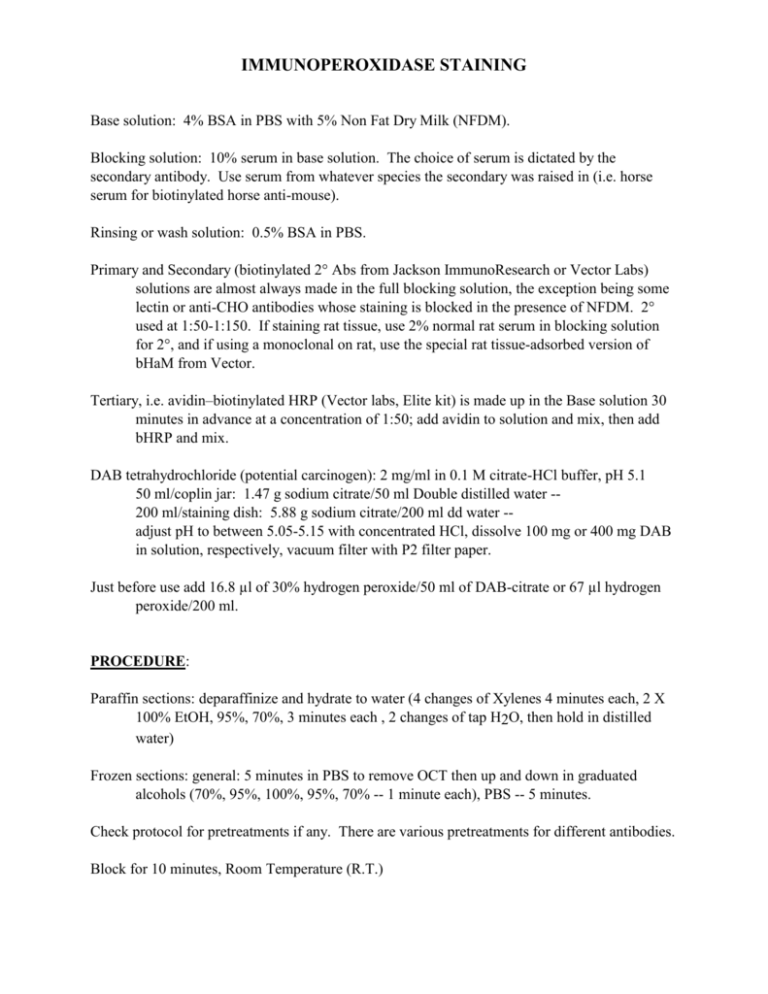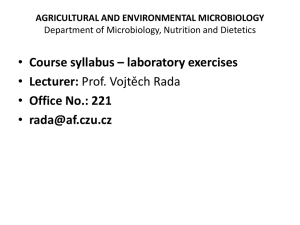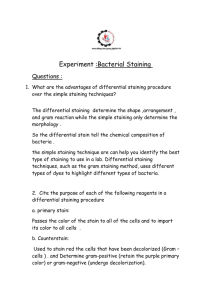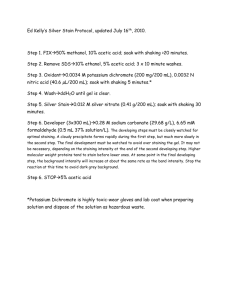alternate protocol 2
advertisement

IMMUNOPEROXIDASE STAINING Base solution: 4% BSA in PBS with 5% Non Fat Dry Milk (NFDM). Blocking solution: 10% serum in base solution. The choice of serum is dictated by the secondary antibody. Use serum from whatever species the secondary was raised in (i.e. horse serum for biotinylated horse anti-mouse). Rinsing or wash solution: 0.5% BSA in PBS. Primary and Secondary (biotinylated 2° Abs from Jackson ImmunoResearch or Vector Labs) solutions are almost always made in the full blocking solution, the exception being some lectin or anti-CHO antibodies whose staining is blocked in the presence of NFDM. 2° used at 1:50-1:150. If staining rat tissue, use 2% normal rat serum in blocking solution for 2°, and if using a monoclonal on rat, use the special rat tissue-adsorbed version of bHaM from Vector. Tertiary, i.e. avidin–biotinylated HRP (Vector labs, Elite kit) is made up in the Base solution 30 minutes in advance at a concentration of 1:50; add avidin to solution and mix, then add bHRP and mix. DAB tetrahydrochloride (potential carcinogen): 2 mg/ml in 0.1 M citrate-HCl buffer, pH 5.1 50 ml/coplin jar: 1.47 g sodium citrate/50 ml Double distilled water -200 ml/staining dish: 5.88 g sodium citrate/200 ml dd water -adjust pH to between 5.05-5.15 with concentrated HCl, dissolve 100 mg or 400 mg DAB in solution, respectively, vacuum filter with P2 filter paper. Just before use add 16.8 µl of 30% hydrogen peroxide/50 ml of DAB-citrate or 67 µl hydrogen peroxide/200 ml. PROCEDURE: Paraffin sections: deparaffinize and hydrate to water (4 changes of Xylenes 4 minutes each, 2 X 100% EtOH, 95%, 70%, 3 minutes each , 2 changes of tap H2O, then hold in distilled water) Frozen sections: general: 5 minutes in PBS to remove OCT then up and down in graduated alcohols (70%, 95%, 100%, 95%, 70% -- 1 minute each), PBS -- 5 minutes. Check protocol for pretreatments if any. There are various pretreatments for different antibodies. Block for 10 minutes, Room Temperature (R.T.) Primary Ab: 1.5 hour, R.T. or overnight at 4°C. Rinse 3 x 5 minutes in BSA-wash Secondary Ab: 1 hour R.T. Rinse 3 x 5 minutes Tertiary reagent: 45 minutes R.T. Rinse 3 x 5 minutes DAB: 8 minutes Rinse well with water Dehydrate through alcohols and clear with xylene Coverslip with DPX Notes Regarding Procedure: 1) Fixation of the tissue: We routinely use three types of material in the lab. (i) Bouin’s fluid-fixed (75 ml saturated picric acid [Sigma], 25 ml formalin [commercially prepared 37% formaldehyde, with preservatives], 5 ml acetic acid: Perfusion fixation (push and drip), some postperfusion immersion fixation (4-8 hrs), either cryostat or paraffin sectioned, also some whole mount stuff. Very good for OMP, GAP-43 and TuJ-1 staining, particularly on cryostat sections for the last two. Best for routine histology of the olfactory epithelium. (ii) Periodate-lysine-paraformaldehyde (PLP)-fixed (with the concentration of paraformaldehyde varying between 0.5 and 2%; McLean and Nakane, 1974, J. Histochem. Cytochem., 22: 1077): Perfusion fixation (push and drip), cryostat sectioning. Very good for general screening. Most antigens stand up to this fixative at 0.75% formaldehyde and allow some degree of staining (the exception being some antikeratin antibodies), including vimentin and neurofilament antibodies (maximal sensitivity is seen with organic solvent fixed and cryostat sectioned in these cases, but the fixation is good enough that the tissue looks OK). It also permits decalcification with saturated EDTA (see below) prior to OCT embedding and cryostat sectioning. Very good for NCAM, other cell surface antigens. (iii) Organic solvent-fixed (either Carnoy’s solution [60 ml absolute EtOH, 30 ml chloroform, and 10 ml glacial acetic acid] or a commercial preparation called Omni-Fix II from An-Con Genetics, Melville, NY), paraffin-embedded: Push some fixative through after clearing out blood with PBS, then immersion fix for 4-18 hours, depending on the size of the tissue. Used for BrdU staining, some intermediate filaments (with pretreatments, see below). For those very refractory intermediate filament antigens, can sometimes get away with organic solvent fixation, rehydration, decalcification and cryostat sectioning, and the outcome is better than trying to cut undecalcified, unfixed tissue, but still not great. This tissue doesn’t hold together very well. 2. Decalcification: We routinely strip the heavy frontal and nasal bones off the nasal skeleton and olfactory bulb after fixation and then use two forms of decalcification to decalcify the smaller turbinate bones that remain. (i) Formic acid-sodium citrate solution (Armed Forces Institute of Pathology Manual -AFIP): used for Bouin’s-fixed tissue and after rehydration of the organic-solvent fixed tissue in the case of some antigens). 8-24 hours, depending on the age of the animal. (ii) Saturated, neutral EDTA: per 900 ml of ddH2O, add 120 g of disodium EDTA, then SLOWLY add 30 g of NaOH pellets to a pH of 7.3. Everything should go into solution. Requires 3-5 days at 4°C to decalcify the turbinates, but needed for those antigen that won’t stand up to acid decalcification. (iii) RDO: Commercially available Rapid decalcification solution from . A After decal, tissue is either cryoprotected with 30% sucrose, until the tissue sinks or 48 hours, or dehydrated for paraffin-embedding. For the cryostat material, the freezing step is critical for good histology (if too slow, you get a bad “Swiss cheese” freezing artifact). Because orientation and good preservation of structure is important to us, we form an aluminum cup by wrapping a thin layer of foil around a 12 mm tube, and sealing the bottom by twisting. The tissue (maximum size of the block is 20-25 mm long, by about 7-10 mm in diameter -- i.e. the size of the bulb and nasal skeleton of a rat up to the anterior tips of the 2nd endoturbinates) in the cup is surrounded by only as much OCT as is needed to cover it over, then immersed to the level of the OCT in liquid nitrogen. Do not immerse completely, or else the block will crack. Watch to make sure that the top is the last to freeze. It should, at the end, look a bit like the top of a soft ice cream cone, with a swirl that is extruded as the deeper part of the OCT freezes and expands. Remove the cup from the liquid nitrogen and put in a -80° freezer when the top is not completely frozen, i.e. when the center 3 mm or so is still liquid at the top. Too long in the liquid nitrogen causes cracking, too little causes freeing artifact. 3. Sectioning -- routine is 8 m for cryostat and 5 m for paraffin, can go down to 3-4 and 2, respectively. Mount either on “Plus” slides from Fisher. 4. Pretreatments of the tissue prior to staining. (i) The alcohol dehydration and rehydration of cryostat sections improves penetration of antibodies into the tissue and lowers background by extracting lipids. Alternatively can use acetone for more complete delipidation. Do not use if staining for a ganglioside antigen. (ii) Methods to restore antigenicity of tissue that is too harshly fixed or paraffinembedded have generally involved protease treatment (proteinase K at 20 g/ml for 5-20 min). In many cases we have found a simple 20 min pretreatment with 0.1-1 M NaOH to be as or more efficacious, besides being faster, easier and cheaper (presumably breaking some of the cross links and producing some degree of proteolysis -- like in the Lowry protein assay). For example, staining of solvent-fixed, paraffin-embedded sections with anti-cytokeratin 5/6 antibodies is very poor without this NaOH step and very good with it (see JCN 359: 15-37 and 363: 129-146). More recently other labs have turned to some microwave techniques to open up the tissue. (ii) Steamer method of antigen retrieval 5. Modifications for immunofluorescence. The protocol is much the same for immunofluorescence staining as for IP. We have found that the optimum concentration of the primary antibody for IF staining using tagged avidin or streptavidin is 4 times that used for IP staining. If double-labeling is required, use the Jackson IR secondaries that have been raised in donkey and are specifically cross-adsorbed for these purposes. Most recently we have found it very useful to have a double filter set cube (available directly from Chromega in Burlington, VT or via your microscope rep) that allows you to directly visualize Texas red and fluorescein simultaneously. This is obviously useful for double-labeling experiments, but it also very good for low-intensity staining with a single marker because the background autofluorescence is a different color than the specific staining (generally it also reduces the level of tissue autofluorescence to near nil). In addition, with this dual cube you can actually do double labeling with antibodies raised in the same species (like two mouse monoclonals) by sequentially cycling them through the two different tagged avidins (Ab1 through to Av1 then Ab2 through to Av2). The first round deposits Av1 (FITC, for example) around Ab1, the second round deposits Av2 (Texas red) around Ab1 and Ab2. With this dual cube, Ab1 visualizes as yellow and Ab2 visualizes as red, which are discriminable by photography. Obviously, this won’t work if the antigens co-localize at a cellular level, but is quite useful if you need to identify more than 1 cell population on the same slide. A word of caution, although they do sell triple cubes, for simultaneous viewing of FITC, Texas red and UV, UV visualization is really lousy, because the extra glass in the filter causes a huge decrease in UV signal intensity. The other difference is in mounting. IF slides cannot be dehydrated, cleared and covered with DPX. There are a variety of anti-fadent mountants. Vectashield, from Vector is very good for FITC and Texas red (does a better job of suppressing fading than anything I’ve used before). However, the anti-fadent fluoresces with UV wavelength illumination blocking the visualization of any blue signal from AMCA-labeled Abs, DAPI or Hoechst. If you need a blue label, you can use para-phenylenediamine as the antifadent in 10% PBS-90% glycerin (1 g/ml final concentration; Johnson and Nogueria Araujo, 1981, J. Immunol. Meth. 43: 349). 6. Sequential double labelling with IP We have found that you can achieve reasonable double-labeling wit IP material if both antigens are robust. The first round of staining proceeds to Av:bHRP and DAB; the second round proceeds to Av:bHRP and a commercial substrate, either SG or VIP, from Vector. The deposition of DAB blocks access of antibodies and other reagents during the subsequent round of staining. The deposition of a thin coating of DAB also reduces the intensity of the staining with the second antibody when compared to the second antibody used alone (therefore, do the weaker staining antibody first). The slides must be rapidly dehydrated and coverslipped with DPX at the end because both SG and VIP products are weakly water soluble. DAB must be used first, for the same reason (the SG and VIP will fade during a subsequent cycle of staining). You cannot treat the sections with NaOH or alcohols after the DAB in between the rounds of staining as this exposes the underlying antigen-antibody complex for deposition of the reagents used during the second round of staining. Renee Mezza/Jim Schwob Jan 19, 1996 revised April 30, 1999





